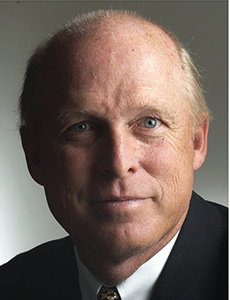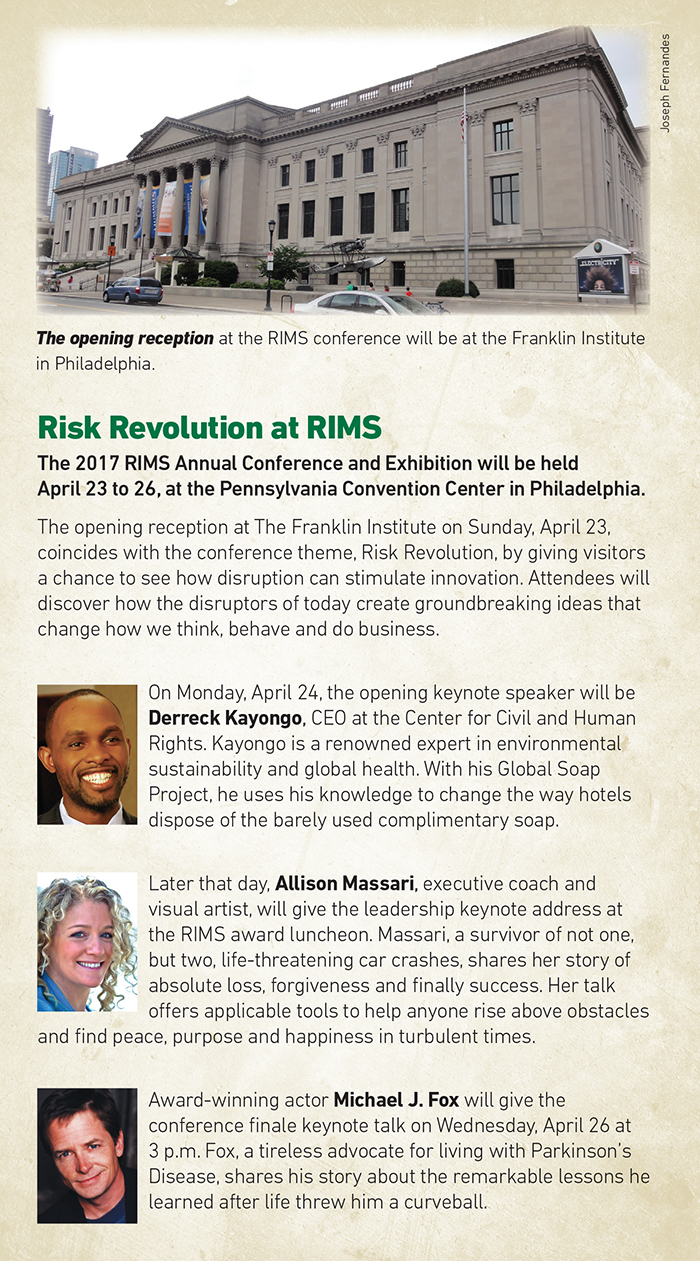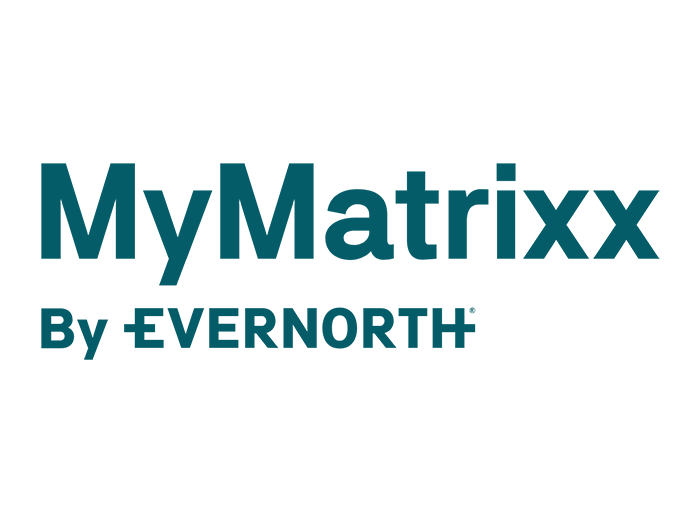RIMS 2017
The Tools to Face Uncertainty

The theme for this year’s annual RIMS conference, “Risk Revolution,” calls on attendees to “disrupt the status quo” in their organizations.
This year in particular will challenge risk managers to change the way they think about the future. Around the world, political upheaval has wrought economic uncertainty. Brexit, Donald Trump’s surprise presidential win, and other populist movements are shattering the very idea of a status quo.
These topics will be the subject of both session presentations and informal discussions among the roughly 10,000 attendees converging on the Pennsylvania Convention Center in Philadelphia from April 23-26.
“We have evolved in an ever-changing business environment so that the status quo is no longer acceptable. It needs to be constantly revisited,” said RIMS CEO Mary Roth. “In every industry, what we did in the past may not be the best way to proceed in the future.”
Patrick Harker, president and CEO of the Federal Reserve Bank of Philadelphia, said in an early January segment on Wharton Business Radio that “my biggest concern is concern. The biggest risk we face is uncertainty.”
Uncertainty is so ominous because unlike a defined risk, it is not necessarily manageable.
“The risk manager is in the midst of a ‘risk revolution,’ evolving into a risk strategist who is required to have plans to deal with both controllable and uncontrollable matters.” — Scott Addis, president and founder, Beyond Insurance
“Risk is best defined as an ‘unknown’ that has a measurable probability of outcome. Uncertainty, on the other hand, involves an unknown with no measurable probability of outcome,” said Scott Addis, president and founder of Beyond Insurance and a speaker at the conference.
“Uncertainty is not quantifiable because future events are too unpredictable and information is insufficient.”
Unanswered Questions
Uncertainty will affect U.S. businesses on multiple fronts. Corporate tax changes and international trade policies are two examples.
Import tariffs and potential trade restrictions imposed with the intention of boosting American manufacturing and job creation could also limit free competition globally and drive up operating costs.
“This can happen in any country that adopts nationalistic policies. From a management perspective, we have to produce at a higher cost,” said Roger Kashlak, professor of international business at Loyola University Maryland and another presenter at RIMS this year.
Restrictive trade policies could also compound the negative impact of a strong U.S. dollar, which makes American exports more expensive and less desirable around the world. With a diminished standing in the global marketplace, it may be hard for businesses to recoup the higher cost of labor that comes with manufacturing at home.
“There’s a cost to this political churn if you play it out. In the short term, you will create jobs that come with tax breaks for businesses, and that’s a good thing. But long term it’s very risky because we’ll miss out on competitive benefits and have higher costs,” Kashlak said.
Regulatory changes also come with a set of pros and cons. In general, less regulatory oversight means more freedom and fewer costs of compliance, which attracts foreign investment and stimulates economic activity. But over the long term, relaxed regulations could be detrimental.
The current administration’s stance on energy regulation offers a good example. If corporations are not held to standards that call for them to reduce emissions of greenhouse gases, and if subsidies for “green” companies are done away with, it provides greater freedom for businesses in every sector to choose how they produce and consume energy. More choices and fewer compliance hurdles are unquestionably good for business.
But without environmental regulation, the long term effects of climate change could also elevate risk for every sector over the long term. And as other countries invest in clean energy resources, the U.S. could lose competitive standing in that industry.
“You have to play it out from both sides,” Kashlak said. “What will we gain, and what will we be missing?”
Unfortunately for risk managers, confusion among the political ranks and strong influence exerted by the general populace on both sides of these issues make it difficult to know just which way the winds will blow.
Planning for the Unknown
Balancing short and long term goals against potential risks in the face of so much uncertainty will be a key challenge for risk managers.
“One of the biggest challenges facing any decision-maker is developing long-term strategies while still recognizing the need to deal with the short term,” said Howard Kunreuther, James G. Dinan professor of decision sciences and business and public policy at the Wharton School and co-director of the Wharton Risk Management and Decision Processes Center at the University of Pennsylvania.

Howard Kunreuther, co-director, Wharton Risk Management and Decision Processes Center, University of Pennsylvania
“We all tend to be myopic by focusing on short term impacts. But corporations, more so than individuals, also recognize the need to develop short term and long term strategies. There is thus a need to build in short term incentives to enable long term planning,” he said.
Short term impacts include end-of-year balance sheets and bonuses. But Kunreuther suggested that insurers should change their way of thinking to broaden what “short term” means. They can, for example, move away from annual property policies and toward three- to five-year terms, which would promote longer term thinking in a way that is still manageable.
Darin Goodwiler, chief compliance, risk and ethics officer at CFA Institute, said that reliable information and intelligence monitoring is the key to being prepared to react to change over the long term.
“One of the biggest challenges in any decision is developing long-term strategies while still recognizing the need to deal with the short term.” — Howard Kunreuther, co-director, Wharton Risk Management and Decision Processes Center, University of Pennsylvania
“Risk managers need trusted and defendable information, and the faster you get it, the better equipped you are to respond to any event,” said Goodwiler, who will also be presenting a session at RIMS.
The challenge, though, lies in the vast amount of information to be gathered, and the question of where to get the best quality, most dependable facts.
“Today, the risk manager is expected to have a keen awareness of a host of issues that range from international trade policies, regulatory updates, immigration laws and import/export tax changes,” Addis of Beyond Insurance said. Risk managers will have to expand their own understanding of political and economic issues, and identify both internal and external resources and experts to fill in the gaps when necessary.
Goodwiler suggested that the best way to start planning for the future is to look back. Examine your organization’s past 20 years; what events made a significant impact, either positive or negative? How did your company respond? Are these repeatable events?
That analysis tips off risk managers to pre-event indicators. In the face of uncertainty, it’s important to be able to tell when an event or change is coming and start a proactive response to mitigate the full negative impact — or in the best case scenario, leverage it to create a positive impact. Know who the decision-makers in your organization are, and have a plan to get information into their hands as fast as possible.
Opportunities for Risk Managers
On the upside, this level of uncertainty opens an opportunity for risk managers to become strategic partners in their organizations. They can take a leading role in data and intelligence gathering, in formulating plans to identify critical upcoming changes and response plans, and in educating senior executives and boards of directors on long term risks.
“The risk manager is in the midst of a ‘risk revolution,’ evolving into a risk strategist who is required to have plans to deal with both controllable and uncontrollable matters,” Addis said.
Recognizing that trend, this year’s RIMS conference features a new Executive Leadership track, which Roth said, “is positioned for senior professionals that are engaged in driving strategy throughout their organization.” Sessions in this track will examine “international strategic planning and ERM, the threats and opportunities of Brexit, and risk and resiliency in the changing world.”
“As leaders in risk management and representatives of the risk management community, we feel it’s imperative to engage our members and attendees in that dialogue and look at ways that others are addressing these changes and challenges,” she said. “We have to provide a forum for individuals to find out what best practices are out there and how other risk professionals are addressing the challenges they’re facing.” &












